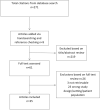Intraoperative Monitoring of the Obese Patient Undergoing Surgery: A Narrative Review
- PMID: 34091873
- PMCID: PMC8179704
- DOI: 10.1007/s12325-021-01774-y
Intraoperative Monitoring of the Obese Patient Undergoing Surgery: A Narrative Review
Abstract
With the increasing prevalence of obesity in the population, anaesthetists must confidently manage both the pathophysiological and technical challenges presented in bariatric and non-bariatric surgery. The intraoperative period represents an important opportunity to optimise and mitigate risk. However, there is little formal guidance on what intraoperative monitoring techniques should be used in this population. This narrative review collates the existing evidence for intraoperative monitoring devices in the obese patients. Although a number of non-invasive blood pressure monitors have been tested, an invasive arterial line remains the most reliable monitor if accurate, continuous monitoring is required. Goal-directed fluid therapy is recommended by clinical practice guidelines, but the methods tested to assess this had guarded applicability to the obese population. Transcutaneous carbon dioxide (CO2) monitoring may offer additional benefit to standard capnography in this population. Individually titrated positive end expiratory pressure (PEEP) and recruitment manoeuvres improved intraoperative mechanics but yielded no benefit in the immediate postoperative period. Depth of anaesthesia monitoring appears to be beneficial in the perioperative period regarding recovery times and complications. Objective confirmation of reversal of neuromuscular blockade continues to be a central tenet of anaesthesia practice, particularly relevant to this group who have been characterised as an "at risk" extubation group. Where deep neuromuscular blockade is used, continuous neuromuscular blockade is suggested. Both obesity and the intraoperative context represent somewhat unstable search terms, as the clinical implications of the obesity phenotype are not uniform, and the type and urgency of surgery have significant impact on the intraoperative setting. This renders the generation of summary conclusions around what intraoperative monitoring techniques are suitable in this population highly challenging.
Keywords: Intraoperative; Monitoring; Obese; Obesity; Perioperative.
© 2021. The Author(s).
Similar articles
-
Intraoperative ventilatory strategies for prevention of pulmonary atelectasis in obese patients undergoing laparoscopic bariatric surgery.Anesth Analg. 2009 Nov;109(5):1511-6. doi: 10.1213/ANE.0b013e3181ba7945. Anesth Analg. 2009. PMID: 19843790 Clinical Trial.
-
Intraoperative Ventilation of Morbidly Obese Patients Guided by Transpulmonary Pressure.Obes Surg. 2018 Jan;28(1):122-129. doi: 10.1007/s11695-017-2794-3. Obes Surg. 2018. PMID: 28707173
-
[EzPAP® therapy of postoperative hypoxemia in the recovery room : experiences with the new compact system of end-expiratory positive airway pressure].Anaesthesist. 2012 Oct;61(10):867-74. doi: 10.1007/s00101-012-2083-4. Epub 2012 Sep 27. Anaesthesist. 2012. PMID: 23011043 German.
-
Clinical Practice Guidelines for Sustained Neuromuscular Blockade in the Adult Critically Ill Patient.Crit Care Med. 2016 Nov;44(11):2079-2103. doi: 10.1097/CCM.0000000000002027. Crit Care Med. 2016. PMID: 27755068 Review.
-
How can I manage anaesthesia in obese patients?Anaesth Crit Care Pain Med. 2020 Apr;39(2):229-238. doi: 10.1016/j.accpm.2019.12.009. Epub 2020 Feb 14. Anaesth Crit Care Pain Med. 2020. PMID: 32068132 Review.
Cited by
-
The patient with obesity and super-super obesity: Perioperative anesthetic considerations.Saudi J Anaesth. 2022 Jul-Sep;16(3):332-338. doi: 10.4103/sja.sja_235_22. Epub 2022 Jun 20. Saudi J Anaesth. 2022. PMID: 35898529 Free PMC article. Review.
-
Pain Control Paradigms: A Comparative Review of Anesthesia Techniques in Trigeminal Neuralgia Therapy.Pain Ther. 2025 Jun;14(3):881-889. doi: 10.1007/s40122-025-00738-2. Epub 2025 Apr 15. Pain Ther. 2025. PMID: 40232612 Free PMC article. Review.
-
The Effect of Phonomyography Prototype for Intraoperative Neuromuscular Monitoring: A Preliminary Study.Bioengineering (Basel). 2024 May 14;11(5):486. doi: 10.3390/bioengineering11050486. Bioengineering (Basel). 2024. PMID: 38790354 Free PMC article.
-
Evaluation of anesthesia-related videos in patients with obesity on the youtube platform in terms of quality, reliability, and usefulness.Medicine (Baltimore). 2025 May 16;104(20):e42445. doi: 10.1097/MD.0000000000042445. Medicine (Baltimore). 2025. PMID: 40388777 Free PMC article.
References
-
- World Health Organization. 2021. Obesity and overweight 2020 [Available from: https://www.who.int/news-room/fact-sheets/detail/obesity-and-overweight.
-
- O'Brien PE, Hindle A, Brennan L, Skinner S, Burton P, Smith A, et al. Long-term outcomes after bariatric surgery: a systematic review and meta-analysis of weight loss at 10 or more years for all bariatric procedures and a single-centre review of 20-year outcomes after adjustable gastric banding. Obes Surg. 2019;29(1):3–14. doi: 10.1007/s11695-018-3525-0. - DOI - PMC - PubMed
Publication types
MeSH terms
LinkOut - more resources
Full Text Sources
Medical


